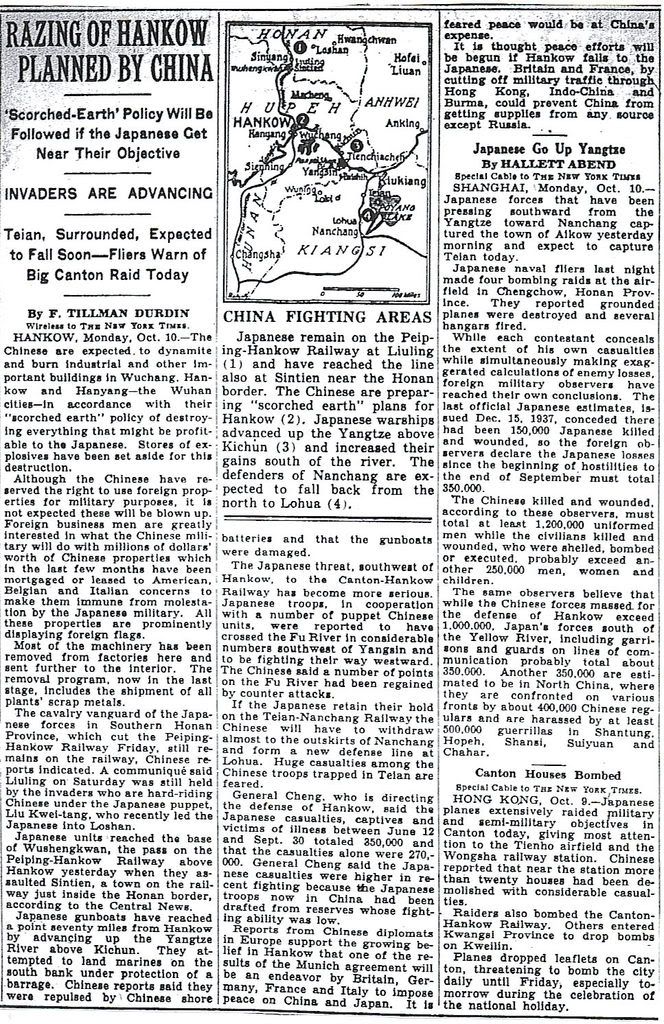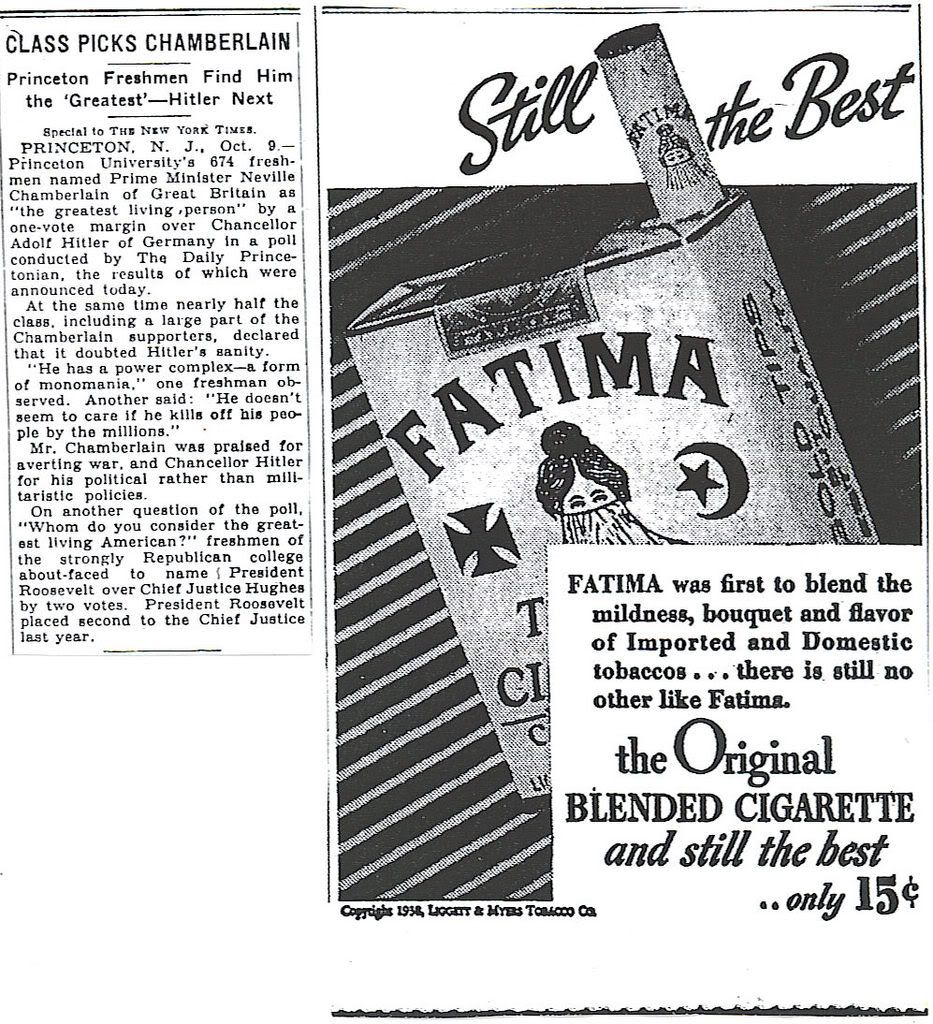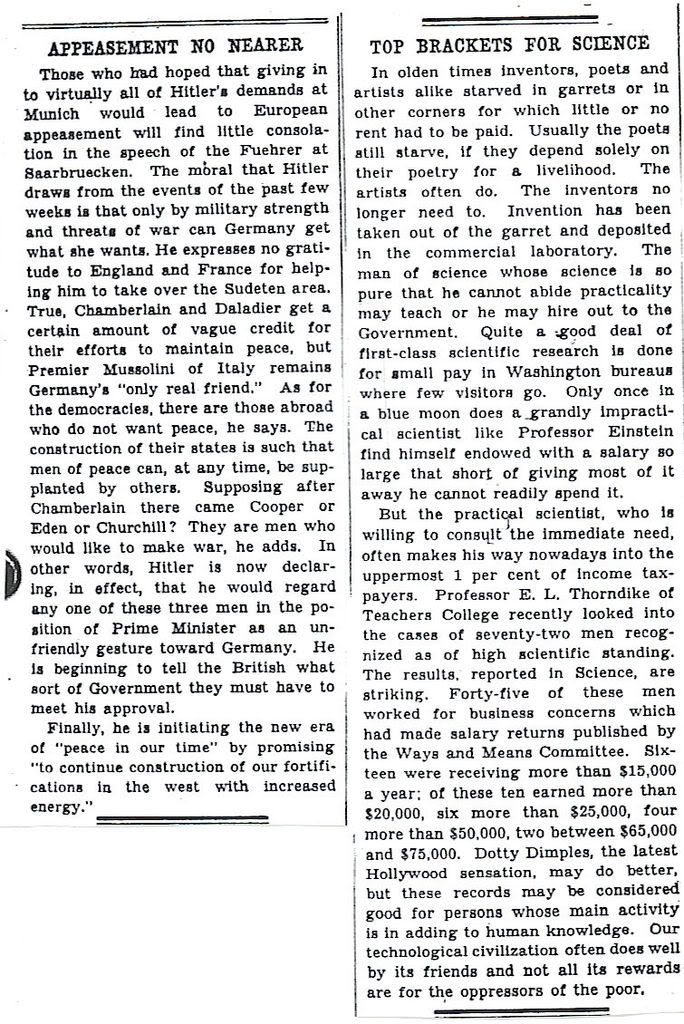
Posted on 10/10/2008 5:45:08 AM PDT by Homer_J_Simpson



Oh that story about the Princeton freshmen is classic!!! Neville Chamberlain eeks out Hitler as the “greatest living person”.
I find it interesting that Chief Justice Charles Hughes, a genuine conservative, would have been so popular among Princeton students. It would be interesting to see how John Roberts, Clarence Thomas, or Antonin Scalia would fare among Princeton students if the vote were taken today.
They attempted to land marines on the south bank under protection of a barrage.
I thought the Japanese didn't have marines.
Princeton's entire class of '42 went to work for Time Magazine after graduation
Something I have noticed is that the word 'appeasement' (as in the editorial "Appeasement No Nearer") had a different meaning before Munich. It referred to the desired end of altering a foreign power's behavior through quid pro quo. Like, when Wiley sits, I give him a cookie. Today appeasement is just something ineffectual politicians to to defer a difficult and inevitable event.
Enjoy the post. I think I will go relax with a Fatima and a cup of coffee before work.
Today, October 10, "Double 10," the anniversary of the 1911 revolution, was China's national holiday at the time. It is still celebrated on Taiwan.
Obama and the Power of Symbols
Beneath the Radar
By Gary Younge
This article appeared in the June 30, 2008 edition of The Nation.
June 12, 2008
———snip
Obama’s race is no insignificant matter. True, he did not run on an antiracist platform. But after considerable reflection, black people flocked to him anyway. As racially charged attacks on him intensified, so did their support for him solidify. He may not have pursued identity politics, but that black Americans identified with him racially made a difference. Those who claimed that the Democratic Party’s problem was that its emphasis on gender and race had alienated white working-class men must now explain why it took a white woman and a black man to give them the best shot at the White House in more than a decade.
Between them, the young and the black increased their share of the Democratic primary electorate by roughly 25 percent compared with 2004—two constituencies that can now assert their place in the Democratic coalition as never before. If the materialists have an alternative project that could engage this number of people in progressive politics, they are keeping it very quiet. In the meantime, you do not have to binge-drink the Obama Kool-Aid to see the possibilities here.
We can try to engage and direct this energy toward a more progressive agenda or abandon it in favor of a more reactionary one. We can pressure his campaign to meet expectations or abandon them to disappointment and cynicism.
While symbols should never be mistaken for substance, they are not insubstantial either.
http://www.thenation.com/doc/20080630/younge
Chilling!
The more things change, the more tings stay the same.
A Fatima and a coffee sounds like a good thing.
The Japanese did not have marines per se, as in the sense of a separate arm of the military.
The United States Marines are probably a unique armed force in the world’s military. Most navies have armed security detachments aboard their naval vessels, and that’s where our Marines started. However, American foreign/military policy always had an element of projection of power through our navy, and the use of armed amphibious forces. Because our army was historically very small and scattered about the country in various posts, the army was not in a position to provide a force just for the projection of military power ashore when quick response was desired. So, when the navy wanted an armed presence ashore and wanted it immediately, the security forces aboard ship were the natural choice. From that, the present Marine Corps evolved.
In WW2, the Japanese were still operating on the same basis as the Americans in the early 19th Century. The Japanese called these forces “Special Naval Landing Detachments.” The American press (and some careless historians) called them Marines, but that connotes the American concept of a Marine Corps. The Japanese forces were not an independent arm of the navy, but were rather ad hoc units formed from naval crews, base personnel, or just whatever happened to be available.
As the war went on, some of those forces could be quite large. It was such a force composed of shore based naval personnel that defended Manila in 1945. The commander ( a naval officer) considered himself outside the Army chain of command in the Philippines, and deliberately disobeyed General Yamashita’s direct order to evacuate the city and not defend it. The naval force was particularly brutal against the civilian population. The atrocities they committed were used as evidence against Yamashita at his war crimes trial. He was convicted and subsequently executed despite an appeal to the United States Supreme Court.
It most certainly is....;)
Dr. Sun was a holiday kind of guy.
I never knew you were a cigarette. (see ad)
:)
That’s me,;)
"The Army was also experienced in landing operations, but it did not have a special corps for such actions. Although doctrine on this subject appeared in 1924, it was not as sophisticated as that developed by the United States Marine Corps. Surprise was emphasized: naval bombardment was slighted. Generally, Japanese operations were simply landings rather than amphibious assaults."
I like yours better.
The fact that Charles Hughes, who was approaching the end of a long political career, was the nation’s leading Republican illustrates the sorry state of the GOP, which had probably reached its nadir in October, 1938. However, things would be looking up for the party a few weeks later, when a number of Republicans, including Robert A. Taft, would be elected.
My guess would along the lines mentioned by henkster, that they were 海軍陸戦隊 (kaigun rikusentai).
Col. Joseph H. Alexander in Utmost Savagery: The Three Days of Tarawa, has this:
Whether the rikusentai were indeed "Marines" is a matter of interpretation, but the fact remains that the Imperial Japanese Navy employed designated landing forces for than a century before World War II. The early version of the Navy's land combat force first appeared in 1830, organized somewhat along the lines of Great Britain's royal marines. Each man-of-war carried a complement of kaiheitai — sailors trained as infantry. Senior Japanese naval officers used such landing parties to quell domestic disorder in Saga Prefecture in 1874 and to conduct pacification missions in Formosa in 1875.Gradually, however, naval officials concluded that such specialized forces were an inefficient use of shipboard assets. In 1886, the government enacted "General Rules for Naval Landing Forces," directing the establishment of land combat forces at naval bases in addition to traditional ships' detachments, thereby creating the kaigun rikusentai. The new organizations drew an allotted proportion of naval recruits and graduates of the Japanese Naval Academy (although most junior officers were reservists). Commanders selected candidates with superior physical fitness and good judgment.
Surprisingly, the world's premier amphibious force in terms of doctrine, tactics, men, and landing craft in the early 1940s was the Imperial Japanese Army. Where the rikusentai were useful in seizing isolated islands or spearheading a larger assault, the army troops were much more effective for amphibious landings in conjunction with sustained land campaigns. This was evident as early as World War I. The rikusentai seized the German-held islands of Saipan, Truk, and the Palaus, while the Army expeditionary forces landed on the Shantung Peninsula to seize Tsingtao.
The rikusentai served for many years in the interwar period in China, but their tactical performance int he Chinese uprising of 1932 left much to be desired. Imperial navy officials realized their landing forces needed more infantry training to retain their value, a goal they achieved slowly. Rikusentai in the 1937 Shanghai Incident fought with greater effectiveness. At the onset of World War II, naval landing forces served as mobile light infantry units, assaulting Guam, Wake (with stiff losses), the Gilberts, Java, Rabaul, and the Solomons. The Army, meanwhile, continued to conduct the larger landings against Hong Kong, Malaya, and the Philippines. Both services performed well in those early campaigns, contributing in their separate ways toward the overall success of Japanese arms in the first months of the war.
Disclaimer: Opinions posted on Free Republic are those of the individual posters and do not necessarily represent the opinion of Free Republic or its management. All materials posted herein are protected by copyright law and the exemption for fair use of copyrighted works.